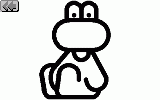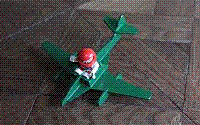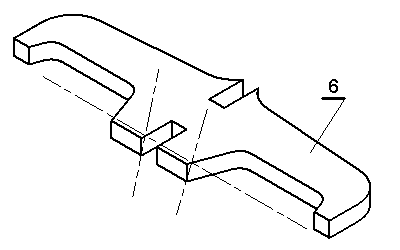
Model building
Bell UH-1 Huey

www.e-rokodelnica.si
 Model building | Bell UH-1 Huey |  www.e-rokodelnica.si |
Here is a plan for a model of helicopter Huey, which is made of plywood. The model is designed to learn sawing with a fretsaw and other skills. Since it is not difficult to make, it is suitable for beginners. The model helicopter is not a flying one, but it can be used as a toy. Because of small parts, it (as a toy) is not suitable for children under three years.

| 
| 
|
It is not allowed to use this document or part of it for commercial purposes. The exception is teachers who may use it at their own classes.
 |
We cut parts of the helicopter out of 4 mm thick plywood first. We find patterns of the parts in a file that is pointed at by a link on figure 1. Each part is to be cut once. Parts, which take part in the assembly twice like fuselage sides 4 or skids 11 are also drawn twice in the drawings. We print the drawing and transfer the patterns to the plywood. A procedure is described in greater detail in the page Transferring Shapes of Parts to Plywood.
  |
  |
Figure 1: Parts of the helicopter
We cut all parts out of plywood as precisely as possible. We can find some tips to help us sawing in the page Using of a Fretsaw. Joints must be cut precisely to make assembling easier.
There are marks for holes on the parts, where axes of main and tail rotors are attached. The A diameter designates holes with interference fit to axis. It is where the axis is fixed. A drill bit diameter should be equal to diameter of axis. If the diameter of nail, which is going to serve as an axis, is 2.0mm, then the drill bit should be 2mm or a bit smaller. Holes designated by B make a loose fit so that rotors could rotate. If the axis diameter is 2.0mm, then the drill bit should be 2.2 mm.
The instrument panel 6 should be prepared before we start to glue. The bottom edge should be sanded to an angle as it is shown on figure 2. This way, the instrument panel 6 could be attached between the cockpit floor 1 and nose 5.

Figure 2: Sanding of bottom edge of instrument panel 6
After that, we sand the parts to remove cutting marks.
 |
Two halves of axis hubs 10 are glued to the tail 8. They are attached to both sides of tail. We must pay attention so that holes in the tail and in the axis hub are aligned. The elevator 9 is glued into a cut in the tail 8. It must be fixed symmetrically. Some possible "inaccuracies" are shown in Figure 4.

Figure 3: Assembly of the helicopter, step 1

Figure 4: Possible errors at gluing elevator
In the second step, the hull of helicopter is assembled. After glue is cured, the joint of the tail and roof 7 should be sanded flat. This spot is pointed by the arrow in the Figure 5.

Figure 5: Assembly of the helicopter, step 2
Now, the skids 11 are attached to the legs. Then the engine parts 12 and 13 are glued to the roof 7. The holes in the engine parts must be aligned to the hole in the roof.

Figure 6: Assembly of the helicopter, step 3
The main rotor consists of parts 15, 16 and 17. These parts must be fixed in right angles. The holes in parts 15 and 17 must be aligned. Some errors, which might happen during assembly of rotor, are shown on the Figure 8.

Figure 7: Assembly of the helicopter, step 4

Figure 8: Possible errors at gluing main rotor head
The helicopter hull and rotors are prepared for sanding and painting.
After the paint is dried, the rotors are attached to the hull. Two nails with proper diameter are shortened. The nails are used for axes because they have heads. The holes in rotors must be slightly wider than the diameter of the nails so that the rotors can rotate. On the other hand, holes in the hull must be narrower, so that the nail is anchored. We drop some glue, which must be suitable for metals, in the holes in the hull and attach rotors. They must be attached so that they rotate loosely.

Figure 9: Assembly of the helicopter, step 5
 |
The company Bell Helicopter designed this helicopter in the early sixties. At that time, the Vietnam War began, where it was widely used. In fact, they were learning how to use helicopters during this war. The original name of helicopter was HU-1. There stems its nickname Huey, which has never been helicopter's official name.
A helicopter is 17.4m long with its rotor included. It maximum speed is above 200km/h. .
 |